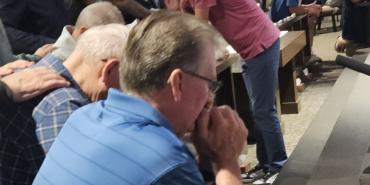Sixty-Year Secret

She had been made aware of a great need. She had responded to a plea. Church of the Nazarene leaders had made it known that missionaries would have to be brought home due to lack of funding. With the dramatic onset of the Great Depression in 1929, and the devastating economic effects in the ensuing months, Nazarenes from all over the world would have to answer the call of sacrificial giving to keep the missionaries in the harvest fields. One of those willing Nazarenes was living in a little village called Owens, West Virginia. She was my maternal grandmother, Christine Moore.
Born in 1899, she lived most of the 20th century. Shortly after my grandmother died in 1994, Mother was sorting through some of her mother's belongings and found a letter. The paper, Christmas stationery from Nazarene Publishing House, was yellowed and dry.
Only my grandmother and her husband had known about the events, more than 60 years earlier, preceding the letter. She had never told any part of this story to her family. She simply did it, and now this fragile piece of paper tucked down in the bottom of a dresser drawer for decades was the only clue.
My grandmother had decided to mail her diamond engagement ring to Kansas City so that it could be sold and the proceeds utilized to fund the continuing work of missions.
Most likely, it was the only material thing of any value that she possessed. But for a greater purpose—evangelizing the lost around the world—she was willing to let it go. The letter was dated December 15, 1930, and it had come from M. Lunn, the manager of Nazarene Publishing House. His letter was sent as a "thank you" for her gift and as an assurance that the proceeds would be used for missions.
The inspiring part of the story is not only the sacrifice, but the secret. Christine Moore had embraced what Jesus taught in his most famous sermon: "When you give to the needy, do not let your left hand know what your right hand is doing, so that your giving may be in secret" (Matthew 6:3-4). She understood that giving wasn't for display. Giving was for impact and purpose.
It was missional giving, in response to a need.
As we approach the Church of the Nazarene's Centennial celebration in October, this story was a reminder to me that my own heritage, and that of so many others, had a strong connection point in "giving." Sacrificial, secretive giving has been a part of our heritage from the beginning. Stories abound about when a college was on the brink of bankruptcy or a local church was about to go under and someone stepped forward and responded to a president's or a pastor's appeal. That's just part of who we are as followers of Jesus...as Nazarenes.
Brad Estep is pastor of Winter Haven, Florida, First Church of the Nazarene.
Holiness Today, May/June 2006
Please note: This article was originally published in 2008. All facts, figures, and titles were accurate to the best of our knowledge at that time but may have since changed.




